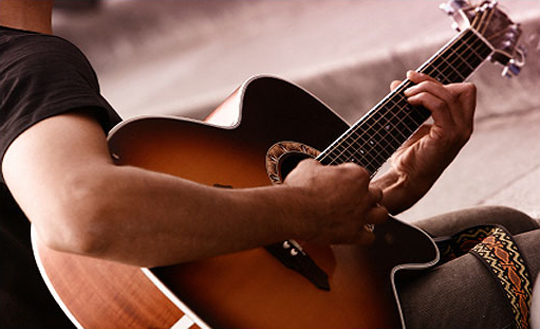
As a full time repair tech, I would say that set ups are probably the most common procedure I do in the shop on the average day. And probably 90% of the guitars that come through the door need a fret level and recrown along with the set up. I thought I would share with you the process I go through to inspect frets and what is actually involved in a fret level, as well as some of the reasons your guitar’s frets became undeveloped in the first place.
When I assess a guitar for set up, the first thing I do is sight down the neck. I want to see how much ” relief ” or bow is in the neck. I like to have the neck as straight as possible to check for unlevel frets, twist in the neck, and humps in a certain part of the fret board. I also like to move the truss rod a bit to make sure it works properly.
Once I have sighted the neck and made necessary adjustments to make sure it is straight, I take a fret rocker (multi sided straight edge) and check the frets, three at a time to make sure they are level. If I encounter a high fret, the straight edge will teeter back and forth to the other two lower frets on each side. I always check on the bass side, middle , and treble side while the guitar is tuned to pitch. Because the frets are over radiused before installed, they have a bit of spring to them. Frets can become unlevel on one side or the other as well as the middle, causing buzzing on specific areas and strings.
Once I have determined the need for a fret level, I remove the strings and adjust the truss rod again to make sure the neck is straight. I may mark certain areas of the frets with a sharpe that visually stand out as high spots in the fret board. I pay close attention to what the neck was like with string tension as well as with out to see how the plain of the neck changes. I want to account for these changes when leveling.
Depending on the severity of unlevelness, I will use either a leveling bar with 220 grit sand paper or a single cut fret leveling or mill file. I always check for loose frets that maybe glued before I start leveling. I prefer a leveling bar or file over a radiused block so I can better control the amount of material I take off in a certain area.
Once I have milled the frets level I need to go through with a crowning file to make the frets round again. I use a 150 grit diamond crowning file and then touch up with a 300 grit crowning file.
Once the frets are levels and crowned I go through the process of dressing the frets with 360, 400, 600, steel wool, and 800 grit. Then I follow with micro mesh sanding pads that go from 1500 to 12,000 grit. I finally finish with a light buffing compound and a buffing wheel on my Dremel tool to give the frets a smooth, mirror like finish. At this point I am ready to string and setup the instrument.
Unlevel frets is very common problem that can show up on new guitars as well as used instruments. Buzzing and sizzling sounds in a specific area are common signs of unlevel frets as well as divots and wear from general playing, which can cause intonation issues as well as buzz. Set ups are general maintenance for guitars and fret levels are needed on well played instruments to insure even playability so if you haven’t had your guitar looked at in a while, take time to visit your favorite guitar tech. You’ll be glad you did!
Posted By: Dave Anderson
Read more about the author: http://www.riverfronttimes.com/2012-12-06/music/dave-anderson-interview-tritone-guitar/

Hi, Nice video. What is the typical cost for this fret level and recrown service?
Thanks,
Frank
Would you suggest having guitars setup when you first purchase one? I have a Les Paul copy that I bought at a garage sale that I had to buy a new stopbar tailpiece and strings for as well as an Epiphone Dr100 Acoustic that I bought new but have never had setup.